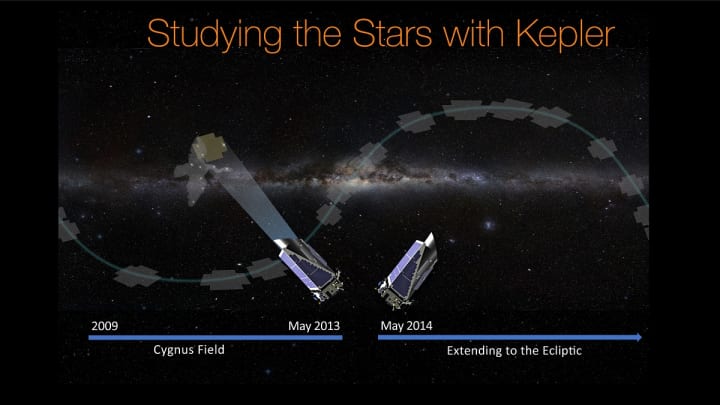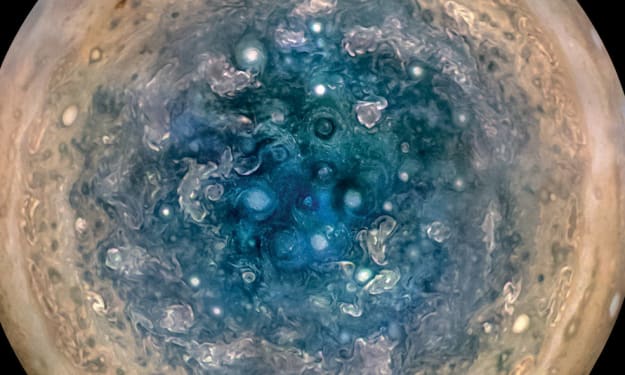Exoplanet Update: NASA Releases New Kepler Data
The latest data released at a media event held at the Ames Research Center in California on Monday, June 19, 2017

NASA released the latest data from the Kepler space telescope project. A total of 219 objects were identified as new planet candidates. More significantly, 10 of those were determined to be possible Earth-like exoplanets which orbit their star at a distance called the habitable zone, where water could exist in a liquid state.
The Results

The population of exoplanets detected by the Kepler mission (yellow dots) compared to those detected by other surveys using various methods: radial velocity (light blue dots), transit (pink dots), imaging (green dots), microlensing (dark blue dots), and pulsar timing (red dots). For reference, the horizontal lines mark the sizes of Jupiter, Neptune and Earth, all of which are displayed on the right side of the diagram. The colored ovals denote different types of planets: hot Jupiters (pink), cold gas giants (purple), ocean worlds and ice giants (blue), rocky planets (yellow), and lava worlds (green). The shaded gray triangle at the lower right marks the exoplanet frontier that will be explored by future exoplanet surveys. Kepler has discovered a remarkable quantity of exoplanets and significantly advanced the edge of the frontier.
Image & caption by NASA/Ames Research Center/Natalie Batalha/Wendy Stenzel
The results come from the first four years of the Kepler mission, and its final survey of the area around the Cygnus constellation. It brings the total number of planets discovered by the Kepler space telescope to 4,034, with 2,335 of those verified as exoplanets, (or planets that orbit a star/sun).
"We like to think of this study as classifying planets in the same way that biologists identify new species of animals," Benjamin Fulton, a doctoral candidate at the University of Hawaii in Manoa, and lead author of the second study, said in a media release. From the raw data that Kepler accumulates about the light emitted by distant bodies, scientists can determine what kinds of planets make up the catalog. Precise determinations can also be made about their size. There are gas giants like Jupiter and Saturn, frozen liquid planets like Uranus, and rocky exoplanets more like Earth, along with anomalies such as rocky planets which seem Earth-like, yet accumulate hydrogen or helium gas clouds to swell to about four times the size of our home planet.
The Kepler/K2 Missions

Kepler was the first NASA mission capable of detecting Earth-size planets, using the transit method, a photometric technique that measures the minuscule dimming of starlight as a planet passes in front of its host star. For the first four years of its primary mission, the space telescope observed a set starfield located in the constellation Cygnus (left). New results released from Kepler data today have implications for understanding the frequency of different types of planets in our galaxy and the way planets are formed. Since 2014 the Kepler telescope has been taking data on its extended second mission, observing fields on the plane of the ecliptic of our galaxy (right).
Image by NASA/Ames Research Center/Wendy Stenzel
The Kepler space observatory was launched into an orbit around the sun 2009. It was designed to survey a specific area of the Milky Way, hunting for exoplanets that were roughly the same size as Earth, and which orbit within the habitable zone. It has far exceeded initial expectations of a 3.5 year lifespan, and despite a few technical glitches along the way, it has continued to transmit data. In 2013, because of a few of those glitches, the mission was modified and renamed K2, using the Kepler spacecraft's remaining intact technology. The range of view was expanded, and along with Earth-like exoplanets, K2 is now studying supernovas and the formation of stars, and bodies formed early in the solar system's formation, such as asteroids and comets.
Kepler's groundbreaking data will help NASA design future missions. The next step will be to target specific Earth-like exoplanets with imaging missions that can gather more data close up. NASA scientists spoke to reporters about the findings, available in detail at the public NASA Exoplanet Archive, at a media event held at the Ames Research Center in California on Monday, June 19, 2017.
About the Creator
Anya Wassenberg
I'm a long time freelance writer of both fiction and non-fiction.






Comments
There are no comments for this story
Be the first to respond and start the conversation.